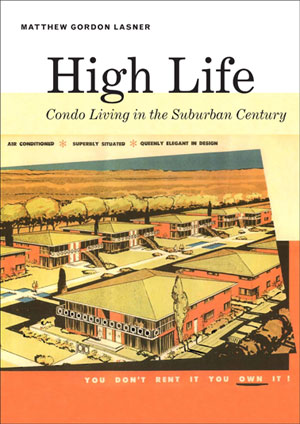This superb study of co-owned housing in America-from the first cooperative apartment buildings in 19th-century New York City to condominiums around the country today-is not only an architectural history but also a social, political, urban, economic, and political one. With only 125 black-and-white images, the author manages to provide enough information for the reader to picture those apartment buildings and townhouses, while he explains the socioeconomic circumstances under which they were created.

High Life: Condo Living in the Suburban Century, by Matthew Gordon Lasner. Yale University Press, 2012, 336 pages, $40.
He notes that the first co-ops appealed particularly to single women (most single men lived in hotels or with their parents) and small families (large ones preferred houses). He describes early multistory luxury co-ops in Manhattan, lower-density ones for the middle class in Queens, and early-20th-century commercially built co-op apartment complexes in mostly East Coast cities and suburbs. He also discusses the first not-for-profit, moderate-income co-op complexes around New York, which were influenced by housing reformers like Clarence Stein and built by progressive groups or unions in the 1920s and after World War II. The idea was to pool resources to create communities of like-minded (mostly left-wing) people, who weren’t allowed to rent out or resell their units at a profit.
In the postwar period, “it was the elderly, primarily in Florida, who made co-ownership a truly mainstream dwelling practice in the US,” Lasner explains. “Before World War II older people lived with their grown children, in institutional homes for the aged or infirm, or in residential hotels… Increasing longevity coupled with trade union pensions and Social Security (introduced in 1935) made the postwar era the first in which ordinary Americans could enjoy a comfortable retirement.” Unlike earlier co-ops, which resembled rental apartment buildings architecturally, those built largely for the retired assumed new forms—assertively modern, high-rise and low-rise, with balconies to enjoy fresh air, and amenities such as swimming pools and golf courses.
Condominiums became popular in California when land grew scarce around San Francisco and Los Angeles, the latter of which, says the author, had been the first big city composed mainly of spread-out single-family houses. But by the 1960s, “a majority of new homes…under construction in Southern California’s fourteen counties were multifamily…in the city of L.A., three-quarters” were. Most were townhouses or in low-rise buildings with private outdoor space and nearby parking. Like the freestanding subdivision houses before them, they appeared in many styles and colorful palettes, and many had “Spanish” touches.
High Life ends up in New York where it began, and where the housing-reform movement had made possible the first large, moderate-income complexes. In the postwar period, another progressive accomplishment, rent control, discouraged the building of new market-rate rental housing. Most new apartment buildings for the middle and upper classes were therefore condominiums, and many existing apartment buildings were converted to co-ops or condos. In either case, co-ownership became the norm where it began, and demographic trends toward smaller households, later marriage, and greater urbanization suggest that it will become increasingly so throughout the United States.
Already, one-eighth of American homeowners live in co-ops or condos, with higher percentages in cities. Without co-ownership, rates of homeownership would not have grown during the last 50 years. As Lasner reports, “The share of households in owner-occupied, single-family houses in 2007 was precisely the same as it had been in 1960 (49 percent) despite the fact that rates of homeownership had risen from 62 to 68 percent.”
For all these reasons, this is an indispensable book for anyone involved with housing—or simply interested in social trends.



Post a comment to this article
Report Abusive Comment